How Big Can a Black King Snake Get
Mexican Black Kingsnakes are common nonvenomous snakes found in North America.
They are part of the Eastern Chain Kingsnake. A family of snakes well known for their ability to resist venom and eat venomous snakes.
Black Kingsnakes get their name because of their black and deep brown coloration. Despite their name, they have a shimmering enamel that gives them a beautiful blue iridescence in daylight.
When kept as pets they have a simple diet and tolerate handling very well.
What more could you want from a beginner snake?
If you are looking for beginner pet snake, read on to learn how to care for this species…
Table of Contents
- Mexican Black Kingsnake Overview
- Do Mexican Black Kingsnakes Make Good Pets?
- Species Appearance
- Mexican Black Kingsnake Size
- Mexican Black Kingsnake Care Sheet
- Feeding A Mexican Black Kingsnake
- Mexican Black Kingsnake Lifespan
- Mexican Black Kingsnake Enclosure
- Cage and Set Up
- Tank Temperature, Heat Gradient and Humidity
- Mexican Black Kingsnake Temperament
- Are Mexican Black Kingsnake Poisonous?
- Mexican Black Kingsnake Baby
- How Much Do Mexican Black Kingsnakes Cost?
- Mexican Black Kingsnake Facts
- Summary
Mexican Black Kingsnake Overview
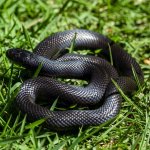
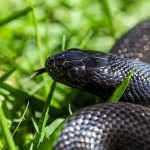
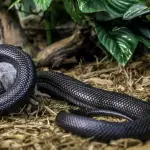
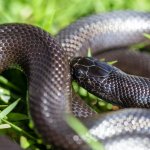
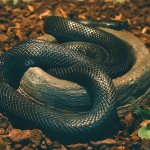
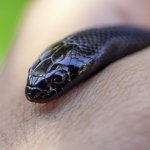
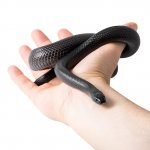
The Mexican Black Kingsnake is a nonvenomous snake native to North America.
They are frequently found throughout the Sonoran Desert, north-western Sinaloa, Mexico, and Arizona.
These black snakes are one of several subspecies of the Eastern Chain Kingsnake and are scientifically grouped in the Lampropeltis getula family.
Black Kingsnakes are known as the Lampropeltis getula nigrita because of their black appearance. Its distinct coloration and lack of patterning distinguish it from heavily patterned relatives.
The name "Lampropeltis" refers to the iridescent enamel on their scales that reflects blue in daylight.
Many herpetologists suggest they should be grouped into a separate lineage of western kingsnakes because of their diversity.
There are many different methods of grouping this species in the United States.
Do Mexican Black Kingsnakes Make Good Pets?
They are a great choice for beginners as they have simple dietary requirements and enjoy being handled. Many beginners keep this pet for more than their black appearance!
These snakes are very active and can be seen hunting and basking during the day:
Pros
- Easily handled by beginners.
- They are very active during the day and spend their time climbing and swimming.
- Easy to feed and have a simple diet of mice.
Cons
- Cannot be cohabitated.
- Can be temperamental as juveniles but become calmer with frequent handling.
- They require a very specific cage set up.
Species Appearance
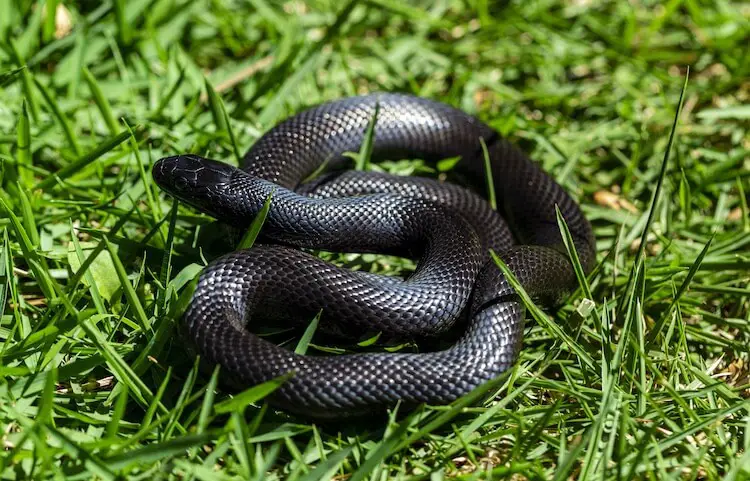
Some beginners occasionally mistake this snake for another Kingsnake or dark corn snake.
Mexican Black Kingsnakes are easily recognized by their completely black appearance – this includes their bellies.
They are the only snake in their family without a pattern. Juveniles only have a few spots under their chins.
To the untrained eye sexing these snakes is nearly impossible without a probe. The only difference is their tail shape. Males and female are generally the same size.
Mexican Black Kingsnake Size
Adults reach around four feet in length after three years of growth. This is typical for most snakes in this family however some other subspecies have been found to be six feet.
Mexican Black Kingsnake hatchlings are born six to eight inches in length. They grow steadily and will double in size each year until they reach their full size.
Mexican Black Kingsnake Care Sheet
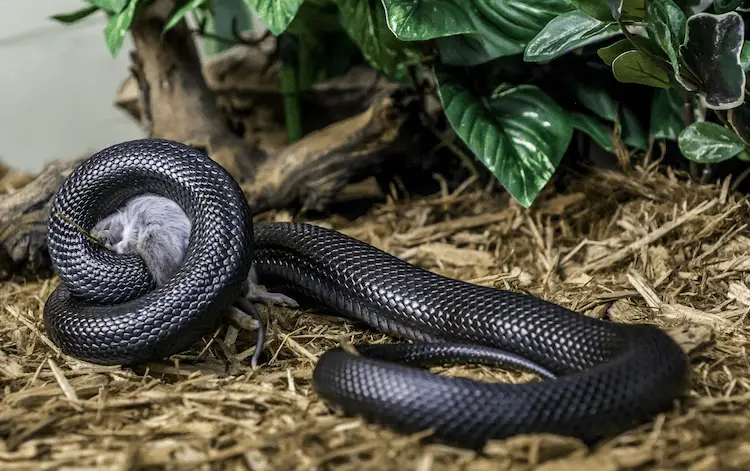
Feeding A Mexican Black Kingsnake
This snake is known for its huge appetite and skilled hunting abilities.
In the wild these opportunistic hunters will eat:
- Birds
- Eggs
- Lizards
- Rodents
- Toads
Interestingly, they will also eat other snakes. This is because they are immune to pit viper venom so are able to kill and eat rattlesnakes and other venomous snakes.
They are a type of constrictor so are very strong and can subdue snakes as large as they are.
This species is capable of eating prey much larger than themselves due to its expanding jaw. However, pet snakes should be fed prey roughly the same diameter as the thickest part of their body.
In captivity they thrive on a diet of frozen thawed mice.
Frozen thawed rodents are recommended because live prey will fight and can give serious scratches that can lead to an infection.
You should thaw their prey just as you would any raw meat. If you forget and are rushed for time, you can also place the bagged rodent in a bowl of warm water (not boiling) to slowly bring the temperature to 98°F.
Frozen thawed rodents are readily accepted by Kingsnakes:
- Babies should be fed every five days.
- After one year of age feeding should be reduced to every 7 – 10 days.
- Adults should be fed every 10 – 14 days and not during shed.
If your pet refuses the rodent then remove it after two hours and place it in the trash can. Do not re-freeze.
Diet enrichment is always a good idea so you can try feeding the occasional frozen thawed chick.
Mexican Black Kingsnake Lifespan
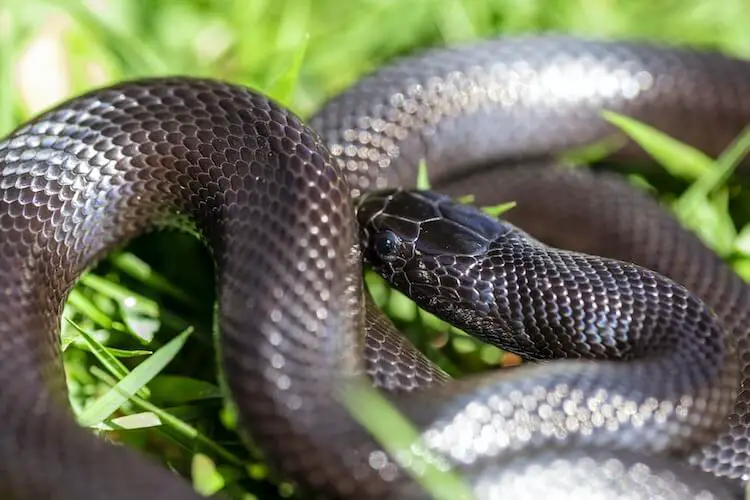
Black Kingsnakes can live up to 25 years in captivity.
The key to a long lifespan is providing correct husbandry and paying attention to your snake's behavior and body condition.
Snakes can develop health problems or illnesses. However, with the proper husbandry and diet many can be avoided:
- Anorexia or auto cannibalism
- Intestinal parasites
- Mouth rot
- Mites
- Respiratory infections
Issues like mouth rot, intestinal parasites and respiratory issues are diagnosed and treated by veterinarians because they normally require antibiotics or medicated soaks.
Your snake's behavior is the only diagnosis you will need for mites. They will shed frequently but rarely produce a full shed. In severe cases they may soak for extended periods of time.
Anorexia or auto cannibalism are behavioral problems often seen in stressed snakes.
Mexican Black Kingsnakes will attempt to eat themselves due to husbandry issues or infrequent feeding.
Signs They Are Healthy
- Consistent feeding.
- Regular and complete shedding.
- Hunting and foraging behaviors.
Sickness Symptoms
- Refusing prey or biting self.
- Stuck shed.
- Wheezing or open mouth breathing.
- Self-soaking for long periods.
Mexican Black Kingsnake Enclosure
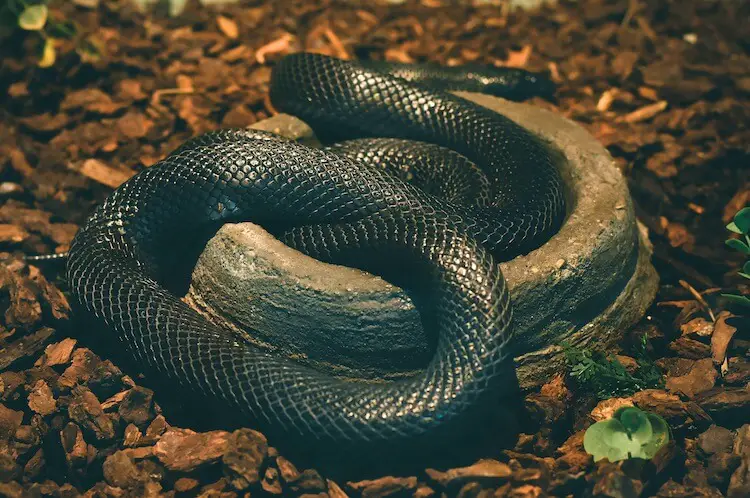
Mexican Black Kingsnakes are primarily terrestrial so tend to stay on or near the ground. Despite their terrestrial lifestyle, these snakes are capable climbers and swimmers so do not be surprised if you see a wild one climbing after a bird nest.
They can be found in both rocky desert areas and regions of vegetation within their range.
To avoid the heat they often use shrubs or rodent burrows to hide.
In the wild Mexican Black Kingsnakes are comfortable near humans so can be found in rural and suburban yards. In developed areas they may be found hiding under wood, tin, or any other debris.
Cage and Set Up
To replicate their wild habitat you should provide natural décor. This will help to give your snake enrichment and allow for normal behaviors such as exploring, climbing and swimming.
You should also offer plenty of basking and hiding areas.
It is important to choose the right type of material for your enclosure. Screen-top enclosures do not hold humidity well and plastic tubs get too hot. Glass or ventilated plastic enclosures work best:
- Tank Type: glass.
- Tank Size: 40-gallons.
- Lighting: basking required.
- Substrate: sand soil mixture.
Babies should be kept in 15-gallon enclosures.
Juveniles and adults need larger tanks that are 20-gallon and 40-gallon respectively.
If their tank is too small they will rub their nose on the glass. This is common when the snake is in a small enclosure.
Longer tanks with more floor space are better as this species is primarily terrestrial.
Because Mexican Black Kingsnakes are found in both desert and vegetative environments multiple substrates can be used. Coconut fiber and soil are okay to use but when used in plastic enclosures they may increase the humidity too much.
A sand and soil substrate mix works best. It will stay loose enough to burrow in and remains moist to control humidity.
Avoid using pine and cedar shavings because they produce irritating dust particles that can cause eye and respiratory issues in snakes that like to burrow.
Tank Temperature, Heat Gradient and Humidity
At night the entire tank should drop to an ambient temperature of 75°F. A low wattage ceramic heat emitter will help to maintain 75°F.
Snakes thermoregulate by moving between warm and cool areas. For this reason, it is important their tank has a temperature gradient:
- The hot side of the enclosure should be 88 – 90°F over a basking surface. This can be achieved using a 75 watt basking bulb over a rock or flat piece of wood in one corner of the tank.
- The ambient temperature should remain 75 – 80°F.
Mexican Black Kingsnake are desert snakes that fare well in moderate humidity (between 40 – 60%) and high temperatures. A tank that is too wet or humid can breed mold and bacteria. This can turn into respiratory issues or scale rot.
You should spot-clean your tank daily to remove feces and any shed.
Every four weeks you should perform a deep clean by changing your snake's substrate and sanitizing all décor.
Mexican Black Kingsnake Temperament
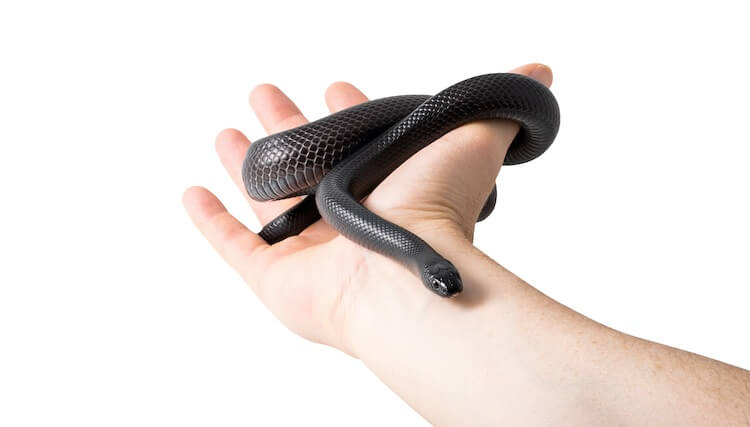
Mexican Black Kingsnakes spend most of their day hunting for prey.
When they catch prey they bite down hard and constrict around it. As they are not venomous they rely entirely on their strength to capture prey.
They are solitary animals that only interact to mate.
If they meet another animal in the wild and feel threatened they will hiss, rattle their tails, flatten their heads, coil up, make jerky movements and even strike.
An angry Mexican Black Kingsnake will musk a foul smelling combination of feces and oils all over you.
In the winter this species will usually find deep holes to burrow in. During this time their metabolism will decrease allowing them to live for four months without feeding.
Mexican Black Kingsnake pets will be very active and exploratory during the day.
In the evening they will often bask and then find a secure hiding place for the night.
Are Mexican Black Kingsnake Poisonous?
They are not venomous. However, they must be handled frequently at a young age.
Without regular handling they may develop an anxious temperament and are more likely to act defensively (e.g. hiss, rattle their tails and strike).
Young snakes can be flighty or mildly defensive but with age and frequent handling they usually grow out of it.
You can try gently picking it up with one hand or scooping with both hands. Either method is typically stress-free.
To prevent infection from any zoonotic diseases (e.g. salmonella) always wash your hands after handling.
Mexican Black Kingsnake Baby
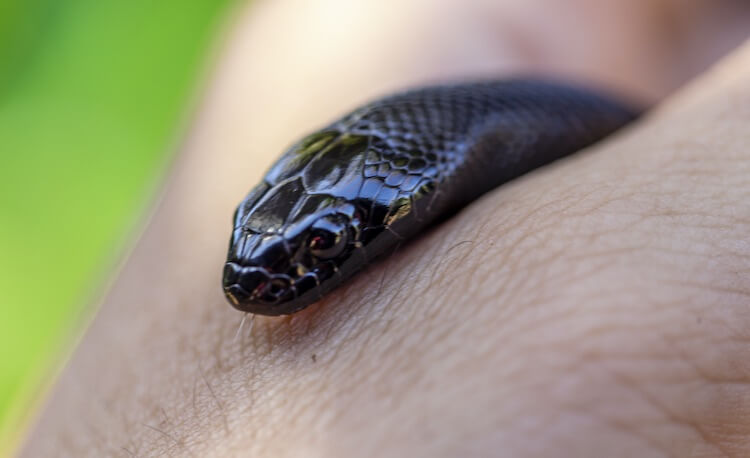
This species of snake lays 6 to 12 eggs (i.e. is oviparous) in the summer. After 65 – 80 days the eggs will hatch. Females do not care for their young so will leave them after laying their eggs.
Mexican Black Kingsnake babies hatch at eight inches in length. They double in size every year until they reach four feet in length.
After hatching they will immediately begin hunting for their first meal.
Babies have yellow spots under their chin or a faint yellow patterning towards the belly. This quickly disappears to a solid black after a few months (pictured above).
How Much Do Mexican Black Kingsnakes Cost?
Mexican Black Kingsnakes are priced between $200 – $250. Size and age will slightly affect the price.
Before purchasing this species you should determine if the snake is captive bred or wild caught.
Wild caught snakes may have diseases, be easily stressed in captivity or be protected in certain states. Purchasing them also places pressure on wild populations – it should be avoided.
You should also make sure the snake is alert and active.
Mexican Black Kingsnake Facts
| Common Name | Black Kingsnake |
|---|---|
| Scientific Name | Lampropeltis getula nigrita |
| Price | ~$200 |
| Size | 4 feet long |
| Lifespan | 15 to 25 years |
| Diet | Mice and chicks |
| Tank Size | 40-gallon glass |
| Humidity & Temperature | Daytime temperature: 75 – 80°F Basking Spot: 88 – 90°F Humidity: 40 – 60% |
| Popular Alternatives | California Kingsnake, Corn Snake and Ball Python |
Summary
Mexican Black Kingsnakes are medium sized hardy snakes that adapt well to captivity and make great pets.
Their beautiful black color and iridescent blue scales makes them very popular. They are also very active during the day and are interesting to watch.
Taming a juvenile Mexican Black Kingsnake and setting up their enclosure can be time consuming, but it is definitely worth the reward!
If you think this snake would be fun to care for but don't have the time to spend on taming then consider other beginner species.
Let us know your experiences in the comments field below.
How Big Can a Black King Snake Get
Source: https://www.everythingreptiles.com/mexican-black-kingsnake/